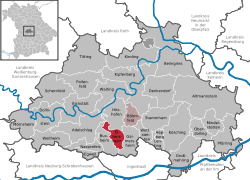Eitensheim
| Eitensheim | ||
|---|---|---|
|
||
| Coordinates: 48°49′N 11°19′E / 48.817°N 11.317°ECoordinates: 48°49′N 11°19′E / 48.817°N 11.317°E | ||
| Country | Germany | |
| State | Bavaria | |
| Admin. region | Oberbayern | |
| District | Eichstätt | |
| Municipal assoc. | Eitensheim | |
| Government | ||
| • Mayor | Michael Stampfer (CSU) | |
| Area | ||
| • Total | 15.72 km2 (6.07 sq mi) | |
| Elevation | 403 m (1,322 ft) | |
| Population (2015-12-31) | ||
| • Total | 2,966 | |
| • Density | 190/km2 (490/sq mi) | |
| Time zone | CET/CEST (UTC+1/+2) | |
| Postal codes | 85117 | |
| Dialling codes | 08458 | |
| Vehicle registration | EI | |
| Website | www.eitensheim.de | |
Eitensheim is a municipality in the district of Eichstätt (district) in Bavaria in Germany.
Eitensheim is located between Eichstätt and Ingolstadt, in Altmühl Valley Nature Park.
Following cities and communes are bordered on the commune Eitensheim: Hitzhofen, Lippertshofen, Gaimersheim, Friedrichshofen, Buxheim and Tauberfeld.
The oldest name of the Eitensheim had been "Itensheim". This means "Home of the Itis", a noble and dignified woman.
In a district of Eitensheim, called "Breitenstückl", the grave of a man was found in 1998 – a farmer and who had died 7000 years before. Relicts which were also found there, are still 1000 years older. Moreover, there were also findings from the Bronze Age, Hallstatt and La Tène period. Roman settlement was proved at the "Sebastianskapelle" and in the southeast of Eitensheim; grave mounds exist and there had been a villa rustica in the south of Eitensheim as well.
Eitensheim, lying at the Roman trade street, belonged in the 8th century to the founded bishopric of Eichstätt as a basic village together with Möckenlohe, Buxheim and Adelschlag. In 908 "Itensheim" had been first mentioned in the document of King Ludwig IV for the bishop of Eichstätt, called Erchanbald. Since then Eitensheim had been closely connected to the chapter of Eichstätt. In 1179, and again in 1186, two-thirds of the taxes of "Itensheim" had been confirmed to the chapter Eichstätt. The first lord of the village had been mentioned as ministerial of Eichstätt in 1122. After a conflict Eitensheim had been adjudged completely to Eichstätt in 1305. In the year 1460 Eitensheim was plundered by Ludwig the Rich during his war against the Earl of Ansbach and the Bishop of Eichstätt.
At the end of the Holy Roman Empire the village consisted of 101 estates, most of them rural. After implementation of feeding, the amount of animals had increased strongly in the princedom Eichstätt. In the 1790s, there had been only 350–400 horned cattle in Eitensheim. Approximately 60 farms had to pay taxes to an office in Eichstätt and 5 farms had to pay taxes to the chapter of Eichstätt. Therefore, the different farms had to pay separately, but there was also a church, a manse, an early mass house, a school and other kinds of buildings.
...
Wikipedia



